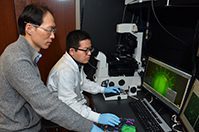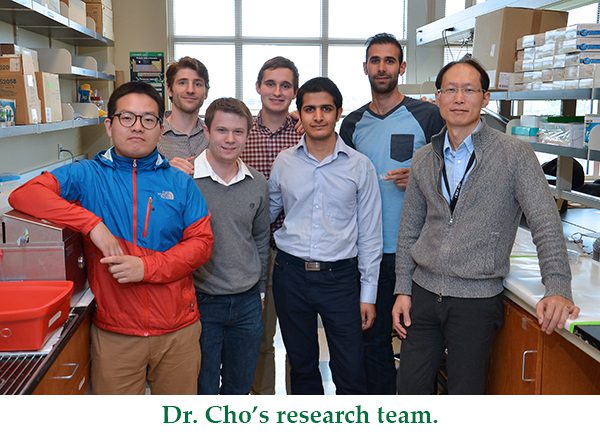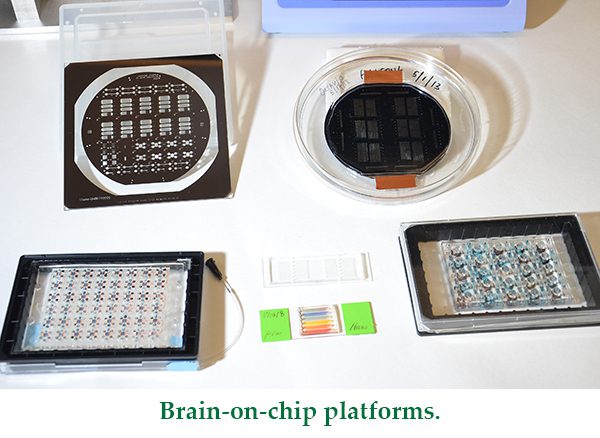Brain-on-Chip Research Mimicks Brain Function

With hundreds of billions of neurons and thousands of trillions of synaptic connections between them, the human brain is the most complex system on earth. This complexity makes studying the brain an almost overwhelming challenge with nearly infinite research options.
“Unfortunately, there are no well-developed brain models to study the brain activities in either laboratory environments or in animal bodies,” said Mechanical Engineering Assistant Professor Dr. Hansang Cho said. “It is hard to regulate and perform image scans of the brain, because their functions are too complicated to interpret and the skull is too thick to image through. My interest is in developing micro-scaled environments that allow us to reconstruct specific brain functions and nano-scaled technologies to measure them.”
To systematize research components into elements that can be understood on their own or in conjunction with one another, Dr. Cho’s research team has developed innovative brain-on-chip devices and monitoring nanotechnologies. Brain-on-chip essentially means micro-scaled platforms that mimic brain functions and allow for unobstructed observations on small controllable devices. As a mechanical engineer in the Lee College of Engineering, Dr. Cho’s expertise in building such devices has led to in-depth research and achieved high-impact international publication about three types of brain chips covering most of brain activities.
 Dr. Cho’s research group is part of the Center for Biomedical Engineering and Science at UNC Charlotte. His work is currently funded by the Cure Alzheimer Fund and the Charlotte Research Institute. The research team includes five undergraduate students, one graduate student, two post-doctoral fellows, and one visiting professor. Among them, four undergraduate students have been selected by summer research programs from ‘Charlotte Research Scholars’, ‘Charlotte Community Scholars’, and ‘Summer Research Experience for Undergraduates’, one postdoctoral fellowship from Korean government, and a poster award of CBES graduate student competition were awarded.
Dr. Cho’s research group is part of the Center for Biomedical Engineering and Science at UNC Charlotte. His work is currently funded by the Cure Alzheimer Fund and the Charlotte Research Institute. The research team includes five undergraduate students, one graduate student, two post-doctoral fellows, and one visiting professor. Among them, four undergraduate students have been selected by summer research programs from ‘Charlotte Research Scholars’, ‘Charlotte Community Scholars’, and ‘Summer Research Experience for Undergraduates’, one postdoctoral fellowship from Korean government, and a poster award of CBES graduate student competition were awarded.
“There are major causes of neurological disorders we are looking into,” Dr. Cho said. “These include the overexpression of biological reagents, which leads to the activation of immune responses inside brains. Our immune system in the brains tries to clear these reagents at a toxic level, but at the same time also kills cells that are inhibiting normal brain functions while trying to save the whole brain system at the expense of sacrificing some brain cells. But through the accumulation of the toxic reagents over ages, brains are continually losing functions and eventually obtain neurodegenerative disorders, dementia including Alzheimer’s disease (AD) and Parkinson’s disease (PD).”
The team is using its brain-on-chip platforms to culture brain cells, which reconstruct specific brain functions. Medical school researchers from Harvard, Yale, the University of Southern California and Rutgers University are providing brain cell materials for testing, and Seoul National University Hospital, Korean University Hospital and Clemson University are collaborating. “They are sharing their knowledge and providing the biological material,” Dr. Cho said.
 The three brain models what Dr. Cho’s team recently developed were designed to measure microglia cell activity in AD environments, construct 3D blood-brain barriers for neurovascular disorders, and investigate how neurotoxic Tau proteins to propagate in AD progression.
The three brain models what Dr. Cho’s team recently developed were designed to measure microglia cell activity in AD environments, construct 3D blood-brain barriers for neurovascular disorders, and investigate how neurotoxic Tau proteins to propagate in AD progression.
“We fabricated a microfluidic platform that provides precise spatial and temporal control of chemokine (chemical attractant) gradients by using photo lithographic techniques. After, we coated the platform with cellular adhesive reagents to promote cellular growth and activation,” Dr. Cho said. “In the microglia study, we grew human microglia, imaged and measured their migration activities responding to various conditions of neurotoxic amyloid-beta peptides in arrayed platforms at a single cellular resolution, real-time measurement, and a high throughput. It is very simple, but very controllable.“
For more information see the Nature article “Microfluidic Chemotaxis Platform for Differentiating the Roles of Soluble and Bound Amyloid-β on Microglial Accumulation.”
Another contributing factor in neurological disorders is a blood-brain barrier (BBB), which gets disintegrated and loses its protective functions in degenerative brains including strokes, AD, and brain cancers.
“We developed a 3D model of BBB in a microfluidic platform,” Dr. Cho said. “Our model provides a robust platform, adequate for detailed functional studies of BBB and for the screening of BBB-penetrating drugs that are particularly effective in neuroinflammatory and hypoxic environments.”
The 3D BBB model is made up of a tube inside a single-layered microfluidic platform. The tube contains endothelial cells and is geometrically similar to small brain blood vessels. The single-layered platform is convenient for integrating with other functional components and assays.
“We envision our platform could be employed for screening new compounds that remove or counteract neurotoxic agents,” Dr. Cho said, “Our platform may also be useful for studying the contribution of various transporters and the emerging role of transcytosis systems to the functionality of BBB in health and disease.”
Working with collaborators from UNC Charlotte’s Chemistry Department and other universities, Dr. Cho’s lab is scaling up and distributing the three-dimensional platforms to evaluate various types of drug carriers effective in brains.
For more information see the Nature article “Three-Dimensional Blood-Brain Barrier Model for in vitro Studies of Neurovascular Pathology.”
 Dr. Cho’s third brain-on-chip is designed to study how neurotoxic phosphorylate tau proteins are spreading through the brain with directionality. Identifying how tau is transferred between neurons is essential for understanding the mechanism and prevention of hierarchical propagation of pathological signatures in Alzheimer’s disease.
Dr. Cho’s third brain-on-chip is designed to study how neurotoxic phosphorylate tau proteins are spreading through the brain with directionality. Identifying how tau is transferred between neurons is essential for understanding the mechanism and prevention of hierarchical propagation of pathological signatures in Alzheimer’s disease.
“The questions are ‘Why does tau protein move in a particular direction?’ and ‘Which particular forms of tau proteins can be preferably transferred across neuronal synapses’,” Dr. Cho said. “It is probably because the forms of toxic tau are overexpressed inside disordered neurons and spread through neurons along specific tracts. But there are billions of tracts in the brain, so it is a very complicated question.”
The team constructed a directional neuronal network in a microfluidic platform and loaded various forms of tau proteins on one side of connected neurons and then trailed them to see how they propagate and move.
“We studied the transfer of tau between neurons using a microfluidic neuron culture platform,” Dr. Cho said. “The design of this platform included three distinct chambers forming layering synaptic connections between neurons, which were plated on different chambers and arrays of microgrooves.”
For more information see the Nature article “Neuronal Uptake and Propagation of a Rare Phosphorylated High-Molecular-Weight Tau Derived from Alzheimer’s Disease Brain.”
The three developed brain-on-chips are currently extensively utilized for the application of drug assessment and combined with other components to reconstitute further complicated brain activities. For example, the team is developing a 3D AD human brain model by co-culturing adult human microglia with AD human neurons provided by a Harvard team who recently published a new 3D AD neuron model in order to study how AD neurons trigger microglia proinflammatory responses that would cause neuronal damage and cognitive impairment. Also his team is developing a new brain model to study axonal degradation and restoration occurring in a traumatic brain injury.
“Our lab-on-chip platforms allow us to mimic various brain activities in a controlled manner, because we design and fabricate the model,” Dr. Cho said. “Our systems are very flexible, so we can created conditions on demand. This is a very complicated, multidisciplinary field, but the research is very promising and very exciting. I like it.”